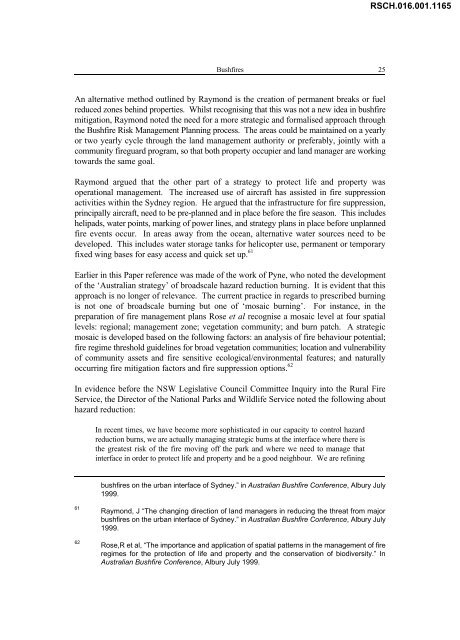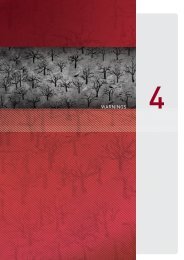RSCH.016.001.1136 - 2009 Victorian Bushfires Royal Commission
RSCH.016.001.1136 - 2009 Victorian Bushfires Royal Commission
RSCH.016.001.1136 - 2009 Victorian Bushfires Royal Commission
Create successful ePaper yourself
Turn your PDF publications into a flip-book with our unique Google optimized e-Paper software.
RSCH.016.001.1165<br />
<strong>Bushfires</strong> 25<br />
An alternative method outlined by Raymond is the creation of permanent breaks or fuel<br />
reduced zones behind properties. Whilst recognising that this was not a new idea in bushfire<br />
mitigation, Raymond noted the need for a more strategic and formalised approach through<br />
the Bushfire Risk Management Planning process. The areas could be maintained on a yearly<br />
or two yearly cycle through the land management authority or preferably, jointly with a<br />
community fireguard program, so that both property occupier and land manager are working<br />
towards the same goal.<br />
Raymond argued that the other part of a strategy to protect life and property was<br />
operational management. The increased use of aircraft has assisted in fire suppression<br />
activities within the Sydney region. He argued that the infrastructure for fire suppression,<br />
principally aircraft, need to be pre-planned and in place before the fire season. This includes<br />
helipads, water points, marking of power lines, and strategy plans in place before unplanned<br />
fire events occur. In areas away from the ocean, alternative water sources need to be<br />
developed. This includes water storage tanks for helicopter use, permanent or temporary<br />
fixed wing bases for easy access and quick set up. 61<br />
Earlier in this Paper reference was made of the work of Pyne, who noted the development<br />
of the ‘Australian strategy’ of broadscale hazard reduction burning. It is evident that this<br />
approach is no longer of relevance. The current practice in regards to prescribed burning<br />
is not one of broadscale burning but one of ‘mosaic burning’. For instance, in the<br />
preparation of fire management plans Rose et al recognise a mosaic level at four spatial<br />
levels: regional; management zone; vegetation community; and burn patch. A strategic<br />
mosaic is developed based on the following factors: an analysis of fire behaviour potential;<br />
fire regime threshold guidelines for broad vegetation communities; location and vulnerability<br />
of community assets and fire sensitive ecological/environmental features; and naturally<br />
occurring fire mitigation factors and fire suppression options. 62<br />
In evidence before the NSW Legislative Council Committee Inquiry into the Rural Fire<br />
Service, the Director of the National Parks and Wildlife Service noted the following about<br />
hazard reduction:<br />
In recent times, we have become more sophisticated in our capacity to control hazard<br />
reduction burns, we are actually managing strategic burns at the interface where there is<br />
the greatest risk of the fire moving off the park and where we need to manage that<br />
interface in order to protect life and property and be a good neighbour. We are refining<br />
bushfires on the urban interface of Sydney.” in Australian Bushfire Conference, Albury July<br />
1999.<br />
61<br />
62<br />
Raymond, J “The changing direction of land managers in reducing the threat from major<br />
bushfires on the urban interface of Sydney.” in Australian Bushfire Conference, Albury July<br />
1999.<br />
Rose,R et al, “The importance and application of spatial patterns in the management of fire<br />
regimes for the protection of life and property and the conservation of biodiversity.” In<br />
Australian Bushfire Conference, Albury July 1999.
















